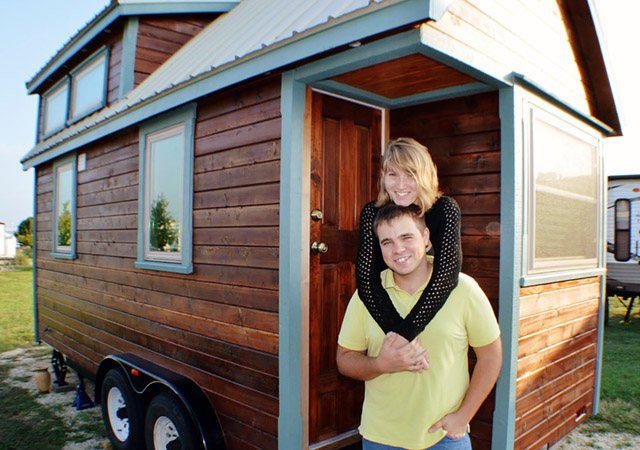Driven by Economics and Lifestyle, Tiny House Movement Grows

Lacey Harrington and her fiancé, Eddie Lanzo, recently moved into their miniature home on wheels, which the couple keeps at an RV park in Georgetown until they can find another spot for a longer period. Photo by Lacey Harrington
By Laura Marina Boria
For Reporting Texas
Lacey Harrington assumed that building a 182-square-foot house would take less time and effort. Until the process started, that is.
“Then you realize you have to make absolutely every single decision” that goes into a regular-size house, she said.
Harrington and her fiancé, Eddie Lanzo, recently moved into their miniature home on wheels, which they keep at an RV park in Georgetown until they can find another spot for a longer period. Tiny houses, as the dwellings are known, are less and less unusual in parts of the country where land and real estate costs have soared.
Austin’s average single-family home price hit an all-time high of $334,758 in March, according to the latest statistics kept by the Austin Board of Realtors. The average cost of a tiny house is $23,000, if built by the owner.
Some tiny house owners also see themselves as part of an environmentally conscious social movement that promotes the downsizing of living spaces.
While the opportunity to own a house without taking out a loan was a great benefit, Lanzo called it a lifestyle experiment as well.
“Just to see what it would be like, how we would interact with the world from such a smaller space and, environmentally, using less energy and not consuming as much,” he said.
Bo Bezdek, who builds custom homes and has been in the tiny-house business for four years, said economic factors motivate many of his clients. “Fifty percent of the people that call me are looking to build a tiny house that they can rent out, either short- or long-term, and make extra revenue,” he said. “The other 50 percent … are downsizing for financial reasons.”
A number of people, Bezdek said, rent out their tiny houses through sites such as Airbnb.com. “They’re doing it as another means of making income in this crazy rental market. Most of the people buying and living in them, they’re coming from out of town,” he said.
The city of Austin’s zoning code does not prohibit the construction of permanent tiny houses or place minimum size requirements on dwelling structures, according to a memo from Greg Guernsey, director of the Planning and Development Review Department. The memo was released last fall.
But owners confront other obstacles. After building on borrowed land in Manor, Harrington and Lanzo faced the challenge of finding a place to park their tiny house. Some RV parks were unsure of whether to treat their house as a permanent structure or as an impermanent one, Harrington said.
For others, putting a tiny house on wheels is a way around code enforcement.
“I don’t believe the code saves people as much as harms people,” said Marnie Khaw, who bought 10 acres outside of Austin and relocated from San Francisco with her partner last November. They live in a second-hand tiny house and are building a new one.
“If you live in your own house, you’ll make sure that it’s safe for you,” Khaw said. “You don’t need government. What government does is just cost you more money.”
Khaw and her partner are seeking investors interested in building businesses or tiny houses on their land, which is in an unincorporated area about 16 miles from the city border. They think their land will be annexed in two to five years, but aren’t worried about that prospect.
Austin officials are revising the Land Development Code as part of the city’s CodeNEXT initiative, and tiny houses are expected to be part of the conversation, said Paulina Urbanowicz, a city planner.
“That’s certainly something that will be looked at, but I’m unable to say when or how for tiny houses,” she said.
Jonathan Tomko, a planner for the Neighborhood Planning Department, said Austin’s real estate market is dominated by single-family homes or multi-family homes, such as apartment buildings.
Tiny houses could be classified as medium-density housing like townhouses, he said. However, Tomko said that including tiny houses in Austin’s Land Development Code will depend on how the City Council responds to recommendations made by consultants.
“I think a lot of people are still hung up on the American dream of a single-family home on a big lot with a car garage,” he said. “That’s not the norm in a lot of cities in America, and I think that’s changing as younger generations see that they can live with less space.”